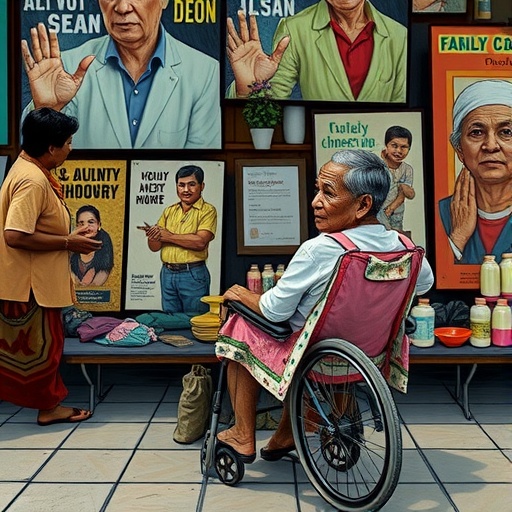In a groundbreaking study published in “Global Health Research and Policy,” researchers have delved into the intricate web of social determinants influencing disability among older Filipinos, unveiling a sophisticated polysocial score methodology that promises to reshape our understanding of aging and health in diverse socio-cultural contexts. This innovative approach transcends traditional biomedical models by integrating multifaceted social factors to more accurately predict and address disability risk, thereby offering a transformative tool for both policymakers and healthcare providers aiming to improve geriatric care in the Philippines and similar settings worldwide.
The phenomenon of disability in aging populations has long been acknowledged as a multifactorial issue, requiring a lens that expands beyond individual health conditions to encompass broader social, economic, and environmental influences. Xu, Li, Cruz, and their colleagues systematically explored these dimensions, recognizing that the aging Filipino demographic confronts unique sociocultural challenges often underrepresented in global health research. Their work pioneers the incorporation of a polysocial score—a composite index aggregating various social determinants—to quantify the cumulative effect these factors exert on disability prevalence and progression.
Central to this research is the identification and operationalization of social determinants that include, but are not limited to, economic status, educational attainment, social networks, neighborhood characteristics, and access to healthcare resources. These variables were meticulously selected based on robust epidemiological evidence and qualitative insights from Filipino communities. The authors contend that no single social determinant adequately captures the nuances of disability risk, hence the polysocial score emerges as a holistic metric embodying the interplay of multiple factors.
Methodologically, the study leveraged longitudinal data from nationally representative surveys, supplemented by community-based assessments to ensure contextual relevance. The polysocial score was calibrated using advanced statistical modeling techniques, including multivariate regression and machine learning algorithms, to discern the relative weight of each social determinant in predicting disability outcomes. This analytic rigor ensures that the score is not only statistically valid but also practically applicable in real-world setting assessments.
Findings from the study underscore the profound impact of compounded social disadvantages on the health trajectories of older Filipinos. For instance, individuals experiencing socioeconomic deprivation coupled with limited social support networks exhibited a disproportionately higher incidence of disability. This synergy of adverse conditions magnifies vulnerability, supporting the hypothesis that social determinants do not operate in isolation but interact dynamically, exacerbating negative health outcomes.
Moreover, the polysocial score’s predictive capacity extends beyond conventional clinical risk factors, offering a nuanced forecast tool for early identification of high-risk older adults. This capability is particularly crucial in resource-constrained environments where healthcare resources must be strategically allocated. Health practitioners can employ the score to tailor interventions that address specific social vulnerabilities, thereby enhancing preventive care and rehabilitation efforts.
The researchers also emphasize the policy implications of their work. Incorporation of polysocial assessments in public health frameworks could galvanize targeted social policy reforms, including improved social protection schemes, community-based support programs, and infrastructural enhancements that foster healthy aging. By quantifying the social burden underlying disability, the study advocates for multidimensional strategies that bridge health and social services, increasingly recognized as pivotal for sustainable eldercare.
Intriguingly, the study highlights variations within subpopulations of older Filipinos—such as those residing in rural versus urban areas—illustrating how social determinants manifest differently across geographic and cultural landscapes. These findings challenge one-size-fits-all approaches and reinforce the necessity of locally adapted interventions grounded in empirical polysocial data.
From a theoretical standpoint, this research advances the discourse on disability by integrating social epidemiology with gerontology and public health policy. The polysocial score exemplifies an innovative analytic paradigm that could be extrapolated to other low- and middle-income countries facing similar demographic transitions. Such scalability underscores its potential to catalyze a global shift towards socially informed health metrics in aging populations.
Crucially, the study does not overlook the ethical dimensions intrinsic to social determinant research. The authors discuss the importance of ensuring that the polysocial score framework respects cultural sensitivities and avoids stigmatization of vulnerable groups. They advocate for participatory approaches in developing and implementing social health assessments, thereby empowering communities and enhancing the legitimacy of health interventions.
The implications of these findings resonate strongly given the projected demographic shifts in the Philippines, where the proportion of older adults is anticipated to increase substantially in coming decades. As the nation grapples with the dual challenge of rising disability and constrained healthcare infrastructure, tools like the polysocial score could prove instrumental in optimizing care delivery and improving quality of life for an aging citizenry.
In summation, Xu, Li, Cruz, and colleagues have charted a pioneering path in geriatric disability research by embedding the complex realities of social determinants within a quantifiable, actionable polysocial score. Their work not only enriches academic understanding but also offers a compelling, practical framework for advancing the health and well-being of older populations in the Philippines and beyond.
This transformative research signals a vital evolution in aging studies, encouraging a paradigmatic shift that elevates social context alongside biomedical factors. As scientists, clinicians, and policymakers digest these insights, the polysocial score may well become a cornerstone in the emerging architecture of socially conscious health strategies aimed at fostering resilient, empowered aging communities worldwide.
Subject of Research:
Exploration of social determinants influencing disability among older Filipino adults using an innovative polysocial score methodology.
Article Title:
Exploring social determinants of disability among older Filipinos: insights from a polysocial score approach.
Article References:
Xu, J., Li, H., Cruz, G.T. et al. Exploring social determinants of disability among older Filipinos: insights from a polysocial score approach. Glob Health Res Policy 10, 55 (2025). https://doi.org/10.1186/s41256-025-00453-7
Image Credits: AI Generated




